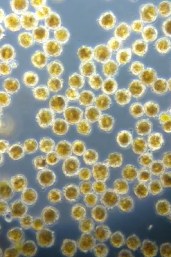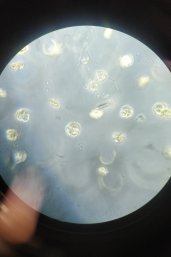Utrecht researchers on the hunt for toxic dinoflagellates
Detectives in subtropical waters
The coastal waters around Florida can suddenly turn red, green or brown, with fatal consequences for manatees, fish and other marine life. The cause: microscopic organisms that can produce toxins. That not only has disastrous consequences for nature, but also for the local tourism and fishing industries, and in some cases even fatal consequences for humans. Scientists have known about the phenomenon for decades, but lately they have begun wondering if the problem is growing, and if humans have had a part to play in that. Researcher Francesca Sangiorgi from Utrecht University’s Faculty of Geosciences will soon travel to Florida with PhD candidate Suzanne de Zwaan to study these harmful microorganisms. Their research is made possible by funding from UU within the UU-NIOZ (Royal Netherlands Institute for Sea Research) collaboration.

The ocean is full of diverse species of microscopic organisms, and several hundred of them are toxic. Florida is mainly troubled by the species Karenia brevis and Pyrodinium bahamense. These are dinoflagellates, more commonly known as a group of ‘microalgae’. Some of the toxins produced by the dinoflagellates can be neutralised at high temperature if they are present in food, like shellfish, but others can be harmful simply by inhaling fine droplets of seawater. “The problem has gained more public awareness since the 1970s, and today we’re seeing more and more reports of outbreaks of toxic organisms”, explains Francesca Sangiorgi. “But is that increase due to us being better able to trace toxic organisms, the toxins themselves and recognise their health effects? Or is the phenomenon becoming more common due to human activity? To answer that question, we’ll be working together with the NIOZ and researchers from regional institutes in Florida.”
Back in time
The American researchers – from Eckerd College (St. Petersburg) and the Florida Fish and Wildlife Conservation Commission – examine the current composition of the seawater, identify the presence of toxic organisms and release public warning messages. Scientists know that dinoflagellates benefit from nitrogen and phosphates that drain into the seawater from agricultural land. “But almost nobody is looking back in time to find out if the presence of these toxic species has changed through time, and why. Some of the methods for doing that still need to be developed. So that’s why our research will focus mostly on this historical aspect.”

Detective work
Suzanne de Zwaan is devoting her PhD research to dinoflagellates. In the laboratory at the NIOZ, she is growing cultures of the two toxic species and examining which substances betray their presence. “In Florida, we’ll take samples from the ocean floor and study them for the presence of those clues.”
Building bridges
“The search for those clues, or as we call them, ‘biomarkers’, hasn’t been easy so far”, clarifies microbiologist Laura Villanueva, who is affiliated with the project on behalf of the NIOZ. “In part because we weren’t sure which biomarkers to look for, but also for a more prosaic reason: the usual separation between the work of a biologist and that of a geologist.” Sangiorgi adds: “So we’re trying to bring those two disciplines closer together.” And if anyone can do that, it’s Sangiorgi, who began her career as a marine biologist.
Fossiles and DNA traces
In addition to looking for biomarkers, the researchers will also examine fossils of the microorganisms and traces of DNA, depending on which species they are dealing with. Sangiorgi and de Zwaan will work in Florida from 25 June to 10 July, and they hope to present their results next year.


